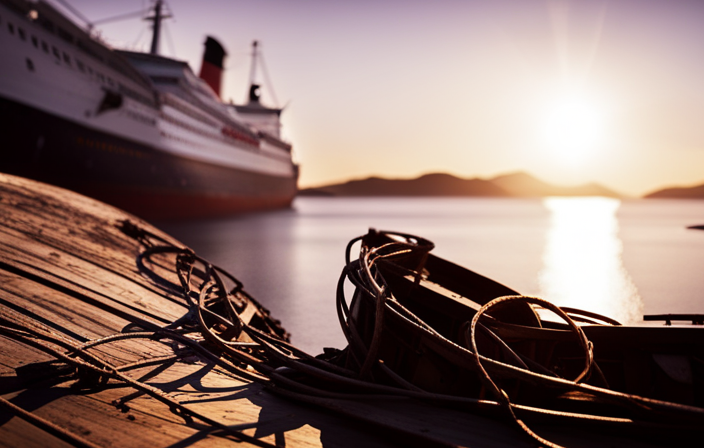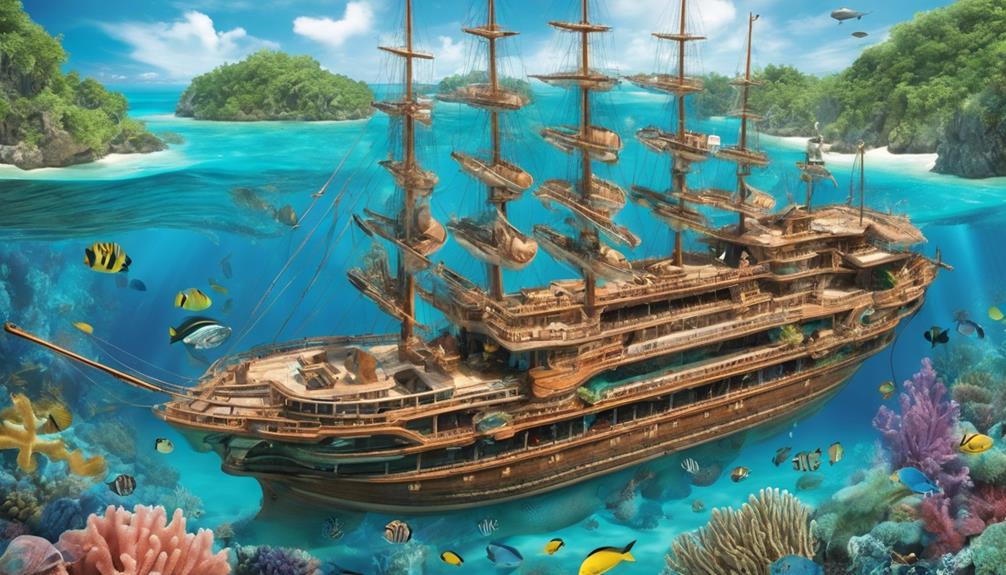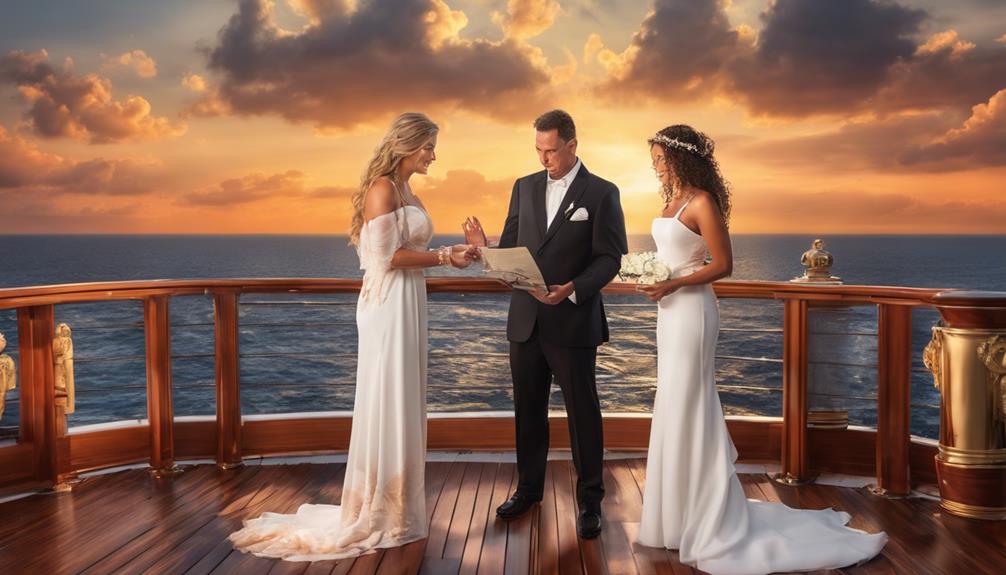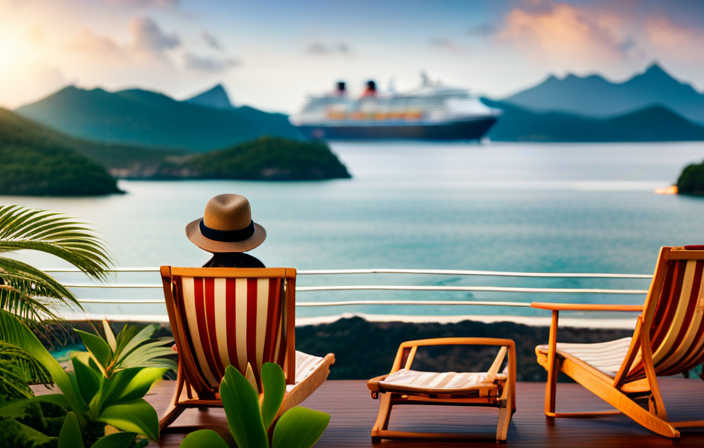Positioned on the deck of an old cruise ship, gazing across the vast ocean, I’m left to contemplate what happens to these magnificent vessels after they’ve completed their numerous journeys. What is the destiny of these large ships that have transported numerous passengers on unforgettable trips? The answer lies in a fascinating tale of transformation and repurposing.
Like a phoenix rising from the ashes, retired cruise ships find new life in various ways. Some are sold to new owners who refurbish them into floating hotels and resorts, offering a unique vacation experience.
Others are transformed into museum ships and tourist attractions, preserving their rich history for future generations.
But the possibilities don’t end there. Old cruise ships can also be repurposed as floating restaurants and entertainment venues, adding a touch of glamour to waterfronts around the world.
And for those looking to give back, some ships are donated to non-profit organizations for humanitarian aid and medical missions.
The fate of these ships is as diverse as the voyages they once embarked upon. Join me as we delve into the world of retired cruise ships and discover the many paths they take after their final voyage.
Key Takeaways
- Retired cruise ships can be converted into research vessels, fueling scientific exploration and collaboration between universities, government agencies, and private organizations.
- Sinking retired cruise ships as artificial reefs benefits the environment and marine ecosystems, providing new habitats for marine species and promoting biodiversity.
- Preserving old cruise ships as historical landmarks honors their rich history and cultural significance, boosting local economies and creating jobs through tourism.
- The challenges in preserving old cruise ships include the cost of maintenance, finding suitable locations for housing, and overcoming obstacles to ensure their preservation.
Retirement and Sale to New Owners
Old cruise ships don’t just sail off into the sunset; they get retired and sold to new owners, embarking on a new adventure on the open seas.
Retirement planning for these magnificent vessels involves careful consideration of market demand and finding the right buyer. The cruise industry is constantly evolving, and what was once a luxury ship may not meet the expectations of modern travelers. So, it’s important to assess the market and find a buyer who sees the potential in the ship’s unique features.
Once sold, these retired cruise ships often undergo a transformation into floating hotels and resorts. This allows them to continue their journey, providing guests with a one-of-a-kind experience. From elegant accommodations to world-class amenities, these floating marvels offer a new chapter in their maritime life, catering to travelers seeking a different kind of adventure on the high seas.
Transformation into Floating Hotels and Resorts
These majestic vessels have been transformed into floating hotels and resorts, offering guests a unique and luxurious experience on the open seas. Imagine waking up to breathtaking ocean views, indulging in world-class cuisine, and enjoying a wide array of activities and amenities.
Here are three reasons why these floating hotels are becoming increasingly popular:
-
Unparalleled views: From your stateroom balcony, you can witness the beauty of the sea, with ever-changing landscapes and stunning sunsets.
-
Endless entertainment: These floating hotels boast a multitude of entertainment options, including Broadway-style shows, live music performances, and even casinos.
-
Resort development: Many cruise ships have been transformed into floating resorts, complete with swimming pools, spa facilities, and fitness centers, providing guests with a vacation experience like no other.
As guests aboard these magnificent vessels create unforgettable memories, it’s also fascinating to explore the next step in their journey – conversion into museum ships and tourist attractions.
Conversion into Museum Ships and Tourist Attractions
Now imagine stepping into a whole new world as these majestic vessels are reborn as captivating museum ships and thrilling tourist attractions.
Cruise ships, once retired from their ocean voyages, are often converted into educational exhibits that showcase the rich history and grandeur of the maritime industry. These floating museums offer visitors a unique opportunity to explore the inner workings of a ship, learn about its construction, and discover the fascinating stories of the people who once sailed on it.
Some retired cruise ships are even transformed into underwater museums, where visitors can dive beneath the surface and explore the shipwreck in its oceanic resting place.
As we delve into the next section about repurposing these ships as floating restaurants and entertainment venues, we’ll discover the exciting possibilities that await.
Repurposing as Floating Restaurants and Entertainment Venues
Imagine stepping into a whole new world as these majestic vessels come alive as captivating floating restaurants and entertainment venues.
Repurposing old cruise ships as dining establishments and entertainment venues offers an economically viable solution for these retired giants of the sea. By transforming these ships into unique dining experiences or hosting live performances, they become a draw for tourists and locals alike, providing an alternative use that generates revenue and creates jobs.
However, it’s important to consider the environmental impact of repurposing these ships for non-tourism purposes. The conversion process requires careful planning to ensure that waste and pollution are minimized, and that the surrounding marine environment is protected.
As we explore the fascinating world of repurposing cruise ships, it’s also essential to delve into the next chapter: dismantling and recycling for scrap, where these magnificent vessels reach the end of their seafaring journey.
Dismantling and Recycling for Scrap
When these retired giants of the sea have reached the end of their seafaring journey, it’s time to embark on the process of dismantling and recycling for scrap, ensuring that materials are repurposed and resources are conserved.
Dismantling techniques for old cruise ships involve carefully removing various components such as engines, generators, and electronics. These are then sent for recycling or sold as spare parts.
The hull, which is usually made of steel, is cut into manageable pieces and sent to recycling facilities. This process not only salvages valuable materials but also reduces the environmental impact of these massive structures.
Recycling old cruise ships helps to minimize waste and prevents the release of hazardous materials into the environment.
As we transition into the subsequent section about conversion into floating art installations and cultural centers, we find that these dismantling techniques pave the way for a new life for these retired vessels.
Conversion into Floating Art Installations and Cultural Centers
Transforming retired giants of the sea into floating art installations and cultural centers allows you to experience the rebirth of these majestic vessels as vibrant hubs of creativity and community. These floating art installations are not only a feast for the eyes but also serve as platforms for artists to showcase their works and engage with audiences.
They provide a unique setting for cultural events, such as art exhibitions, performances, and workshops, fostering a sense of inclusivity and inspiration. By repurposing old cruise ships in this way, we are able to breathe new life into these once bustling vessels, creating spaces that bring people together and celebrate the power of art and culture.
Donation to Non-Profit Organizations for Humanitarian Aid and Medical Missions
Donating retired giants of the sea to non-profit organizations for humanitarian aid and medical missions infuses these majestic vessels with new purpose. They become vital resources for delivering essential supplies and providing medical assistance to communities in need.
The donation impact is immense. These ships are equipped with the infrastructure necessary to support large-scale relief efforts. They can transport food, water, and medical supplies to disaster-stricken areas, reaching places that are difficult to access by land.
Additionally, these ships can serve as floating hospitals, providing much-needed medical care to underserved populations. Funding sources for these donations often come from a combination of private donors, government grants, and corporate sponsorships.
Transitioning from their previous role as cruise ships, these vessels now embark on a new journey as lifelines for those in crisis.
Next, we will explore how old cruise ships are transformed into research vessels for scientific exploration.
Conversion into Research Vessels for Scientific Exploration
The majestic vessels of the sea take on a new purpose as they are converted into research vessels, fueling scientific exploration and discovery. Research collaborations between universities, government agencies, and private organizations have transformed these retired cruise ships into floating laboratories equipped with state-of-the-art technology and research facilities. Funding sources for these conversions come from a variety of avenues, including government grants, private donations, and corporate sponsorships.
Research collaborations allow scientists from different fields to come together and conduct cutting-edge studies on various subjects, such as marine biology, oceanography, and climate change.
The converted research vessels serve as platforms for collecting crucial data and samples from remote and inaccessible areas of the ocean, enabling scientists to better understand the mysteries of the deep sea.
These vessels also facilitate international collaborations, as they can be deployed to different regions around the world, promoting global scientific cooperation.
As these research vessels continue to make groundbreaking discoveries, they eventually find their final resting place as artificial reefs, providing habitats for marine life and promoting marine conservation efforts.
Sinking as Artificial Reefs for Marine Life Conservation
Sink these retired vessels as artificial reefs and watch as marine life flourishes in their new underwater homes.
Sinking old cruise ships as artificial reefs has numerous benefits for both the environment and marine ecosystems. When these massive structures are purposely sunk, they create a new habitat for a variety of marine species to thrive.
The sunken ships provide a solid foundation for corals to attach and grow, attracting a diverse array of fish, crustaceans, and other marine organisms. Additionally, the crevices and hiding places within the shipwrecks offer protection for smaller marine life, promoting biodiversity and creating a balanced ecosystem.
Not only does this provide opportunities for scientific research and education, but it also contributes to the conservation of marine biodiversity. By transforming retired cruise ships into artificial reefs, we can ensure that these once majestic vessels continue to benefit the environment even after their days of carrying passengers have come to an end.
As we explore the next step of preserving these ships as historical landmarks and heritage sites…
Preservation as Historical Landmarks and Heritage Sites
Preserving retired vessels as historical landmarks and heritage sites allows us to honor their rich history and cultural significance. However, it is not without its challenges.
One of the main preservation challenges is the cost involved in maintaining these old cruise ships. From regular maintenance to restoration work, the expenses can quickly add up. Additionally, finding suitable locations to house these massive vessels can also be a difficulty.
Despite these challenges, the economic impact of preserving cruise ships as historical landmarks and heritage sites can be significant. These retired vessels attract tourists from all over the world, boosting local economies and creating jobs. Visitors are drawn to the unique experience of exploring these historic ships, learning about their past, and immersing themselves in the maritime culture.
Preserving cruise ships as historical landmarks and heritage sites not only ensures that their stories are remembered, but also provides economic benefits for the communities they are located in. It is a way to celebrate and appreciate the legacy of these iconic vessels while contributing to the local economy.
Frequently Asked Questions
Are there any safety measures in place when cruise ships are transformed into floating hotels and resorts?
Yes, there are safety precautions in place when transforming cruise ships into floating hotels and resorts. Measures include fire safety systems, emergency evacuation plans, and compliance with international safety regulations. Additionally, efforts are made to minimize the environmental impact through waste management and energy efficiency.
How are cruise ships selected to be converted into museum ships and tourist attractions?
When selecting cruise ships to be converted into museum ships and tourist attractions, a thorough selection process is followed. Criteria such as historical significance, structural integrity, and potential for restoration are evaluated to ensure the ship’s suitability for preservation and public display.
Are there any restrictions or regulations for repurposing cruise ships into floating restaurants and entertainment venues?
There are restrictions and regulations for repurposing cruise ships into floating restaurants and entertainment venues. These include ensuring compliance with health and safety standards, obtaining the necessary permits, and mitigating any potential environmental impacts. The economic impact of repurposing cruise ships can be significant, as they can attract tourists and generate revenue for local businesses. However, there are also environmental concerns associated with this practice, such as pollution from increased maritime activity and the potential impact on marine ecosystems. It is important to carefully consider these factors when repurposing cruise ships.
What is the process for dismantling and recycling a cruise ship for scrap?
When dismantling a cruise ship for scrap, the first step is to remove all hazardous materials. Then, the ship is cut into sections using heavy machinery. The sections are then sold for recycling, with materials like steel and aluminum being salvaged for reuse.
How are cruise ships converted into floating art installations and cultural centers?
To convert cruise ships into floating art exhibitions and cultural centers, historic vessels are repurposed with careful consideration of their architectural features. The process involves transforming the ship’s interior spaces into galleries, theaters, and event venues, creating unique and immersive cultural experiences.
Conclusion
In conclusion, the fate of old cruise ships is as diverse as the seas they once sailed.
These majestic vessels can find new life as floating hotels, museums, or even restaurants.
Some are dismantled and recycled, while others are donated for humanitarian aid.
A select few become research vessels, exploring the mysteries of the deep.
And for the ultimate conservation effort, some are sunk to create artificial reefs.
These ships have a story to tell, and their preservation as historical landmarks ensures their legacy lives on, like a captivating tale whispered by the waves.
Alfons is the visionary leader and driving force behind Voyager Info’s success. As the Editor in Chief, he brings a wealth of experience and an unwavering passion for travel to the helm of our cruise-centric platform.
With a lifelong fascination for exploring new horizons, Alfons discovered his love for the ocean and cruising at a young age. From sailing across pristine Caribbean waters to embarking on daring expeditions to far-flung destinations, he has amassed a treasure trove of first-hand experiences in the world of cruising.











